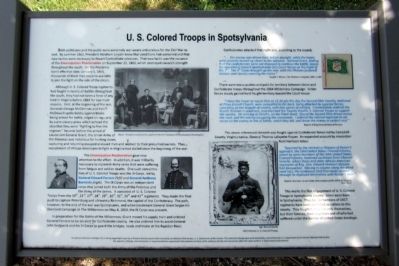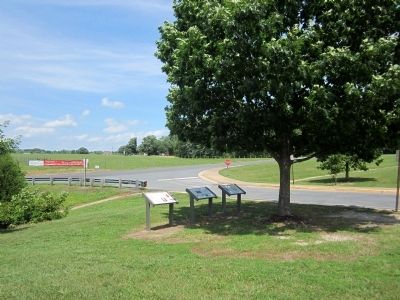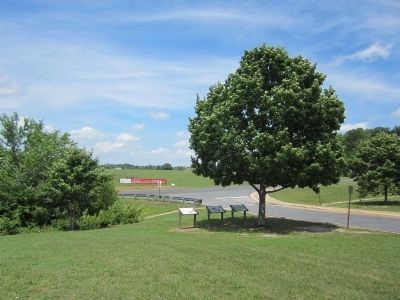Spotsylvania Courthouse in Spotsylvania County, Virginia — The American South (Mid-Atlantic)
U. S. Colored Troops in Spotsylvania
Although U. S. Colored Troop regiments had fought in nearly all battles throughout the south, they had not been a force of any kind in Virginia before 1864 for two main reasons. First, at the beginning of the war, Generals George McClennan and lrvin McDowell spoke boldly against blacks being armed for battle, edged on regularly by a pro-slavery press which echoed the idea that they were "fighting to free the negroes.” Second, before the arrival of Lieutenant General Grant, the Union Army of the Potomac was notorious for hunting down, capturing and returning escaped enslaved men and women to their presumed owners. Thus, recruitment of African Americans to fight in Virginia had stalled since the beginning of the war.
The Emancipation Proclamation gave new attention to the effort. In addition, it was militarily necessary to replenish Army ranks that were suffering from fatigue and soldier deaths. One such concentration of U.S. Colored Troops was the IX Corps, led by General Edward Ferrero (left) and General Ambrose Burnside (right). The IX Corps was an independent corps that joined both the Army of the Potomac and the Army of the James. It consisted of U.S. Colored Troops from the 19th, 23rd, 27th, 28th, 29th, 30th, 31st, 39th and 43rd regiments. They made the final push to capture Petersburg and ultimately Richmond, the capitol of the Confederacy. The path, however, to the end of the war was Spotsylvania, and when Lieutenant General Grant began his Overland Campaign at The Wilderness on May 4, 1864, the IX Corps was present.
In preparation for the Battle of the Wilderness, Grant moved his supply train and ordered General Ferrero to be on alert for Confederate cavalry. He also ordered him to assist General John Sedgwick and his VI Corps to guard the bridges, roads and trains at the Rapidan River.
Confederates attacked that night and, according to the record,
“…the enemy was driven back before daylight, while the trains were securely moved up closer to the advance. General Grant, finding that the confederates were not disposed to continue the battle, begun the movement toward Spottsylvania (sic) Court House on the night of the 7th. The 9th Corps brought up the rear, with the Phalanx [colored] division and cavalry covering the trains.”
Joseph T. Wilson, The Phalanx in Virginia, 1897, p 387.
There were many pushes and pulls for territory between Union and Confederate troops throughout the 1864 Wilderness Campaign. Union forces slowly gained hard-fought territory toward the Court House.
"I have the honor to report that at 12:30 pm this day the Second Ohio Cavalry, stationed at Piney Branch Church, were compelled to fall back, being attacked by superior forces, consisting of one brigade of cavalry, with two pieces of artillery. I immediately ordered the Fourth Division in readiness, and marched the Twenty-third U.S. Colored Troops to support the cavalry. On arriving at AIrich's, on the Plank Road, I found the Second Ohio driven across the road, and the enemy occupying the crossroads. I ordered the colored regiment to advance on the enemy in line of battle, which they did, and drove the enemy in perfect rout."
Report of Brig General Edward Ferrero
The above referenced skirmish was fought against Confederate forces led by Campbell County, Virginia native, General Thomas Lafayette Rosser. An expanded account by researcher Noel Harrison notes:
"Apprised by the retreating Ohioans of Rosser’s approach, the 23rd United States Colored Infantry, joined by some members of the 30th United States Colored Infantry, hastened southeast from Chancellorsville, where those and other African American regiments of Brig. Gen. Edward Ferrero’s division had bivouacked. Moving in column along the plank road (sic), the reinforced 23rd first made contort through its deployed skirmishers with Rosser’s men.”
Noel G. Harrison, In our midst: first combat of the USCTs in Virginia, June 2010
This marks the first engagement of U.S. Colored Troops in Spotsylvania County. Some were born in Spotsylvania. Thus far, 16 members of USCT regiments have been identified as natives to this county. They fought to free not only themselves, but their families, their neighbors and all who had suffered under the banner of United States bondage.
(captions)
(upper left) Above: President Lincoln and his cabinet at the first reading of the Emancipation Proclamation.
(lower right) Sgt. Nimrod Burke, 23rd Infantry, U.S. Colored Troops
The African American Heritage Trail is supported in part by a Preserve America grant administered by the National Park Service, United States Department of the Interior. This product is based upon work assisted by a grant from the U.S. Department of the Interior, National Park Service. Any opinions, findings, conclusions or recommendations expressed in this material are those of the author and do not necessarily reflect the views of the U.S. Department of the Interior.
Topics and series. This historical marker is listed in these topic lists: African Americans • War, US Civil. In addition, it is included in the Former U.S. Presidents: #16 Abraham Lincoln, and the Former U.S. Presidents: #18 Ulysses S. Grant series lists. A significant historical month for this entry is January 1987.
Location. 38° 16.524′ N, 77° 37.512′ W. Marker is in Spotsylvania Courthouse, Virginia, in Spotsylvania County. Marker can be reached from Catharpin Road (County Route 612) 0.9 miles south of Old Plank Road (County Route 610), on the right when traveling south. Located at the entrance to Wilderness Elementary School. Touch for map. Marker is at or near this postal address: 11600 Catharpin Rd, Spotsylvania VA 22553, United States of America. Touch for directions.
Other nearby markers. At least 8 other markers are within 2 miles of this marker, measured as the crow flies. Sergeant Benjamin Brown (here, next to this marker); The Wilderness and the Overland Campaign (here, next to this marker); 23rd USCT At the Alrich Farm (approx. half a mile away); Jackson on the Move (approx. 1.1 miles away); Matthew Fontaine Maury (approx. 1.1 miles away); Maury House Trail (approx. 1.1 miles away); Ordeal of the Wellfords (approx. 1.2 miles away); Rearguard Action (approx. 1.2 miles away). Touch for a list and map of all markers in Spotsylvania Courthouse.
Also see . . . Spotsylvania African American Heritage Trail. (Submitted on June 22, 2015.)
Additional keywords. USCT
Credits. This page was last revised on November 14, 2021. It was originally submitted on June 22, 2015, by Bernard Fisher of Richmond, Virginia. This page has been viewed 539 times since then and 20 times this year. Photos: 1, 2, 3. submitted on June 22, 2015, by Bernard Fisher of Richmond, Virginia.


